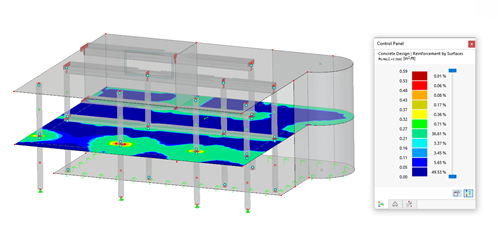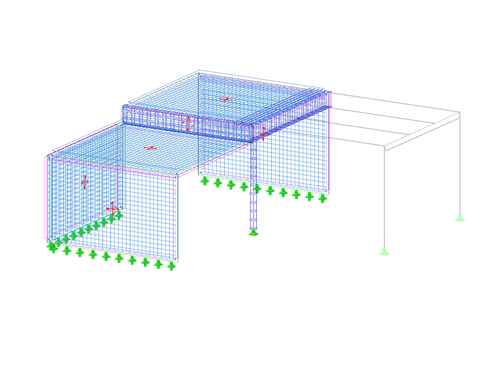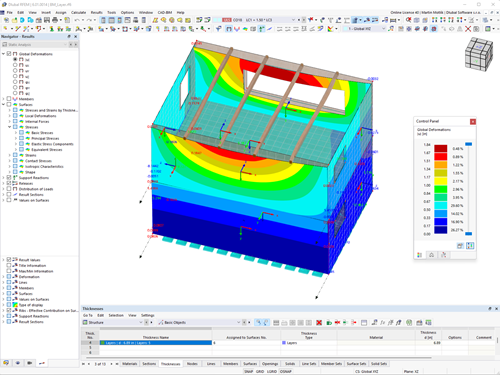In this tutorial, we would like to inform you about the essential features of the RFEM program. The first part shows how to create the structural objects and loads, combine the loads, perform a structural analysis, check the results, and prepare the data for printing. Eurocodes with the CEN settings are used as standards.
In this tutorial, we would like to inform you about the essential features of the RFEM program. The first part shows how to create the structural objects and loads, combine the loads, perform a structural analysis, check the results, and prepare the data for printing. The US codes are used as standards.
The Concrete Design add-on allows you to design reinforced concrete members and surfaces according to various design standards. It is possible to perform the ultimate limit state and serviceability limit state design checks. The input and result evaluation are completely integrated in the user interface of the structural FEA software RFEM and the frame & truss analysis software RSTAB.
This manual describes the Concrete Design add-on for RFEM 6 and RSTAB 9. In RSTAB, you can only design members and member sets, not surfaces.
In this tutorial, we would like to inform you about the essential features of the RFEM program. In the first part, a model was defined and a structural analysis was carried out. The second part deals with the concrete design of the slabs, walls, beams, and the column according to EN 1992‑1‑1 with the CEN settings.
In this tutorial, we would like to inform you about the essential features of the RFEM program. In the first part, a model was defined and a structural analysis was carried out. Now, the second part deals with the concrete design of slabs, walls, beams, and the column. ACI 318-19 is used as a standard.
Dynamic analyses in RFEM 6 and RSTAB 9 can be performed in several add-ons.
- The Modal Analysis add-on is the basic add-on, performing natural vibration analyses for member, surface, and solid models. It is a prerequisite for all other dynamic add-ons.
- The Response Spectrum Analysis add-on allows you to perform a seismic analysis using the multi-modal response spectrum analysis.
- The Time History Analysis add-on allows for a dynamic structural analysis of external excitations that can be defined as a function of time.
- The Pushover Analysis add-on allows you to determine the maximum nonlinear response of a structure to seismic loads.
- The Harmonic Response Analysis add-on is still under development.
This manual describes the dynamic analysis add-ons for RFEM 6 and RSTAB 9.
The Timber Design add-on allows you to design timber members and surfaces according to various design standards. Cross-section resistance checks, stability analyses, and serviceability limit state design checks can also be performed. The input and result evaluation are completely integrated in the user interface of the structural FEA software RFEM and the frame & truss analysis software RSTAB.
This manual describes the Timber Design add-on for the RFEM 6 and RSTAB 9 programs.
The Aluminum Design add-on allows you to design aluminum members according to various design standards. It is possible to perform cross-section resistance checks, stability analyses, and serviceability limit state design checks. The input and result evaluation are completely integrated in the user interface of the structural FEA software RFEM and the frame & truss analysis software RSTAB.
This manual describes the Aluminum Design add-on for the RFEM 6 and RSTAB 9 programs.
The Geotechnical Analysis add-on allows for a finite element analysis of soil solids with the suitable material laws in RFEM 6. By integrating Geotechnical Analysis into the FEA software, the soil-structure interaction can be represented computationally completely in the overall model.
With the Geotechnical Analysis, it is possible to determine the stresses and deformations of a soil solid. The input and result evaluation are integrated in the user interface of the RFEM 6 program.
This manual describes the Geotechnical Analysis add-on for the RFEM 6 program.
The Multilayer Surfaces Add-on allows you to define the layer structure of any material models. In the case of orthotropic materials, the individual layers can be rotated by an angle β, and thus it is possible to consider different stiffnesses by direction. The Multilayer Surfaces add-on is completely integrated in the user interface of the FEA program RFEM.
This manual describes the Multilayer Surfaces add-on for the RFEM 6 program.








